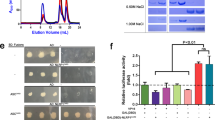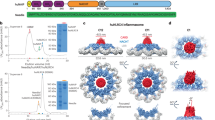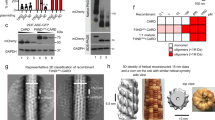Abstract
The nucleotide-binding domain (NBD), leucine rich repeat (LRR) domain containing protein family (NLR family) apoptosis inhibitory proteins (NAIPs) are cytosolic receptors that play critical roles in the host defense against bacterial infection. NAIPs interact with conserved bacterial ligands and activate the NLR family caspase recruitment domain containing protein 4 (NLRC4) to initiate the NAIP—NLRC4 inflammasome pathway. Here we found the process of NAIP activation is completely different from NLRC4. Our cryo-EM structure of unliganded mouse NAIP5 adopts an unprecedented wide-open conformation, with the nucleating surface fully exposed and accessible to recruit inactive NLRC4. Upon ligand binding, the winged helix domain (WHD) of NAIP5 undergoes roughly 20° rotation to form a steric clash with the inactive NLRC4, which triggers the conformational change of NLRC4 from inactive to active state. We also show the rotation of WHD places the 17–18 loop at a position that directly bind the active NLRC4 and stabilize the NAIP5–NLRC4 complex. Overall, these data provide structural mechanisms of inactive NAIP5, the process of NAIP5 activation and NAIP-dependent NLRC4 activation.
This is a preview of subscription content, access via your institution
Access options
Access Nature and 54 other Nature Portfolio journals
Get Nature+, our best-value online-access subscription
$29.99 / 30 days
cancel any time
Subscribe to this journal
Receive 12 print issues and online access
$189.00 per year
only $15.75 per issue
Buy this article
- Purchase on Springer Link
- Instant access to full article PDF
Prices may be subject to local taxes which are calculated during checkout




Similar content being viewed by others
Data availability
The cryo-EM maps were deposited in the Electron Microscopy Data Bank under the accession IDs EMD-24387 (3.3 Å) and EMD-24389 (3.6 Å), and the atomic coordinates were deposited in the PDB under the accession ID 7RAV. Plasmids are available from the corresponding author. Source data are provided with this paper.
Change history
25 January 2023
A Correction to this paper has been published: https://doi.org/10.1038/s41594-023-00927-7
References
Harton, J. A., Linhoff, M. W., Zhang, J. & Ting, J. P. Cutting edge: CATERPILLER: a large family of mammalian genes containing CARD, pyrin, nucleotide-binding, and leucine-rich repeat domains. J. Immunol. 169, 4088–4093 (2002).
Proell, M., Riedl, S. J., Fritz, J. H., Rojas, A. M. & Schwarzenbacher, R. The Nod-like receptor (NLR) family: a tale of similarities and differences. PLoS ONE 3, e2119 (2008).
Rauch, I. et al. NAIP proteins are required for cytosolic detection of specific bacterial ligands in vivo. J. Exp. Med. 213, 657–665 (2016).
Kofoed, E. M. & Vance, R. E. Innate immune recognition of bacterial ligands by NAIPs determines inflammasome specificity. Nature 477, 592–595 (2011).
Zhao, Y. et al. The NLRC4 inflammasome receptors for bacterial flagellin and type III secretion apparatus. Nature 477, 596–600 (2011).
Yang, J., Zhao, Y., Shi, J. & Shao, F. Human NAIP and mouse NAIP1 recognize bacterial type III secretion needle protein for inflammasome activation. Proc. Natl Acad. Sci. USA 110, 14408–14413 (2013).
Reyes Ruiz, V. M. et al. Broad detection of bacterial type III secretion system and flagellin proteins by the human NAIP/NLRC4 inflammasome. Proc. Natl Acad. Sci. USA 114, 13242–13247 (2017).
Duncan, J. A. & Canna, S. W. The NLRC4 inflammasome. Immunological Rev. 281, 115–123 (2018).
Bauer, R. & Rauch, I. The NAIP/NLRC4 inflammasome in infection and pathology. Mol. Asp. Med. 76, 100863 (2020).
Miao, E. A. et al. Innate immune detection of the type III secretion apparatus through the NLRC4 inflammasome. Proc. Natl Acad. Sci. USA 107, 3076–3080 (2010).
Broz, P. & Dixit, V. M. Inflammasomes: mechanism of assembly, regulation and signalling. Nat. Rev. Immunol. 16, 407–420 (2016).
Miao, E. A. et al. Cytoplasmic flagellin activates caspase-1 and secretion of interleukin 1beta via Ipaf. Nat. Immunol. 7, 569–575 (2006).
Hu, Z. et al. Crystal structure of NLRC4 reveals its autoinhibition mechanism. Science 341, 172–175 (2013).
Hu, Z. et al. Structural and biochemical basis for induced self-propagation of NLRC4. Science 350, 399–404 (2015).
Zhang, L. et al. Cryo-EM structure of the activated NAIP2-NLRC4 inflammasome reveals nucleated polymerization. Science https://doi.org/10.1126/science.aac5789 (2015).
Wu, H. Higher-order assemblies in a new paradigm of signal transduction. Cell 153, 287–292 (2013).
Li, Y. et al. Cryo-EM structures of ASC and NLRC4 CARD filaments reveal a unified mechanism of nucleation and activation of caspase-1. Proc. Natl Acad. Sci. USA 115, 10845–10852 (2018).
Tenthorey, J. L. et al. The structural basis of flagellin detection by NAIP5: a strategy to limit pathogen immune evasion. Science 358, 888–893 (2017).
Yang, X. et al. Structural basis for specific flagellin recognition by the NLR protein NAIP5. Cell Res. 28, 35–47 (2018).
Zhang, L. & Wu, H. Bad germs are trapped. Cell Res. 28, 141–142 (2018).
Canna, S. et al. A157: macrophage activation syndrome-like illness due to an activating mutation in NLRC4. Arthritis Rheumatol. 66, S203 (2014).
Scheres, S. H. RELION: implementation of a Bayesian approach to cryo-EM structure determination. J. Struct. Biol. 180, 519–530 (2012).
Punjani, A., Rubinstein, J. L., Fleet, D. J. & Brubaker, M. A. cryoSPARC: algorithms for rapid unsupervised cryo-EM structure determination. Nat. Methods 14, 290–296 (2017).
Jumper, J. et al. Highly accurate protein structure prediction with AlphaFold. Nature 596, 583–589 (2021).
Emsley, P., Lohkamp, B., Scott, W. G. & Cowtan, K. Features and development of Coot. Acta Crystallogr. Sect. D., Biol. Crystallogr. 66, 486–501 (2010).
Afonine, P. V. et al. Real-space refinement in PHENIX for cryo-EM and crystallography. Acta Crystallogr. D. Struct. Biol. 74, 531–544 (2018).
Halff, E. F. et al. Formation and structure of a NAIP5-NLRC4 inflammasome induced by direct interactions with conserved N- and C-terminal regions of flagellin. J. Biol. Chem. 287, 38460–38472 (2012).
Tenthorey, J. L., Kofoed, E. M., Daugherty, M. D., Malik, H. S. & Vance, R. E. Molecular basis for specific recognition of bacterial ligands by NAIP/NLRC4 inflammasomes. Mol. Cell. https://doi.org/10.1016/j.molcel.2014.02.018 (2014).
Poyet, J. L. et al. Identification of Ipaf, a human caspase-1-activating protein related to Apaf-1. J. Biol. Chem. 276, 28309–28313 (2001).
White, S. R. & Lauring, B. AAA+ ATPases: achieving diversity of function with conserved machinery. Traffic 8, 1657–1667 (2007).
Maharana, J., Panda, D. & De, S. Deciphering the ATP-binding mechanism(s) in NLRP-NACHT 3D models using structural bioinformatics approaches. PLoS ONE 13, e0209420 (2018).
Maekawa, S., Ohto, U., Shibata, T., Miyake, K. & Shimizu, T. Crystal structure of NOD2 and its implications in human disease. Nat. Commun. 7, 11813 (2016).
Yuan, S. & Akey, C. W. Apoptosome structure, assembly, and procaspase activation. Structure 21, 501–515 (2013).
Pang, Y. et al. Structure of the apoptosome: mechanistic insights into activation of an initiator caspase from Drosophila. Genes Dev. 29, 277–287 (2015).
Sharif, H. et al. Structural mechanism for NEK7-licensed activation of NLRP3 inflammasome. Nature https://doi.org/10.1038/s41586-019-1295-z (2019).
Wang, J. et al. Reconstitution and structure of a plant NLR resistosome conferring immunity. Science https://doi.org/10.1126/science.aav5870 (2019).
Wang, J. et al. Ligand-triggered allosteric ADP release primes a plant NLR complex. Science 364, eaav5868 (2019).
Erijman, A., Dantes, A., Bernheim, R., Shifman, J. M. & Peleg, Y. Transfer-PCR (TPCR): a highway for DNA cloning and protein engineering. J. Struct. Biol. 175, 171–177 (2011).
Mastronarde, D. N. Automated electron microscope tomography using robust prediction of specimen movements. J. Struct. Biol. 152, 36–51 (2005).
Sanchez-Garcia, R. et al. DeepEMhancer: a deep learning solution for cryo-EM volume post-processing. Preprint at bioRxiv https://doi.org/10.1101/2020.06.12.148296 (2020).
Tan, Y. Z. et al. Addressing preferred specimen orientation in single-particle cryo-EM through tilting. Nat. Methods 14, 793–796 (2017).
Pettersen, E. F. et al. UCSF Chimera–a visualization system for exploratory research and analysis. J. Comput. Chem. 25, 1605–1612 (2004).
Liebschner, D. et al. Macromolecular structure determination using X-rays, neutrons and electrons: recent developments in Phenix. Acta Crystallogr. D. Struct. Biol. 75, 861–877 (2019).
Bryan, N. B., Dorfleutner, A., Rojanasakul, Y. & Stehlik, C. Activation of inflammasomes requires intracellular redistribution of the apoptotic speck-like protein containing a caspase recruitment domain. J. Immunol. 182, 3173–3182 (2009).
Li, J., Yin, H. L. & Yuan, J. Flightless-I regulates proinflammatory caspases by selectively modulating intracellular localization and caspase activity. J. Cell Biol. 181, 321–333 (2008).
Acknowledgements
We thank C. Lopez at the Multiscale Microscopy Core of OHSU, S. Mulligan, N. Meyer and C. Yoshioka at the Pacific Northwest Center for Cryo-EM (PNCC) for their help in cryo-EM data collection. A portion of this research was supported by National Institutes of Health grant no. U24GM129547 and performed at the PNCC at OHSU and accessed through the Environmental Molecular Sciences Laboratory (grid.436923.9), a Department of Energy Office of Science User Facility sponsored by the Office of Biological and Environmental Research. We thank I. Rauch at OHSU for discussion and X. Xiao at OHSU for sharing the HEK293T cell line. This work was supported by the National Institutes of Health grant nos. R00AI137300 and R01AI165580 (L.Z.), and the Medical Research Foundation New Investigator grant no. 1019214 (L.Z.). We apologize to authors whose work could not be cited because of space limitation.
Author information
Authors and Affiliations
Contributions
L.Z., B.P. and J.C. conceived the study. B.P. purified the protein and performed negative stain EM analysis. J.C. made cryo-grids and collected cryo-EM data. L.Z. and J.C. performed data processing. L.Z. performed initial model building, B.P. and Q.X. performed additional refinement. L.Z. and B.P. designed mutants for functional assays, B.P. performed biochemical assays, G.N. did technical replicates. L.Z., B.P., J.C., G.N. and H.W. wrote the manuscript.
Corresponding author
Ethics declarations
Competing interests
H.W. is a cofounder of Ventus Therapeutics. The other authors declare no competing interests.
Peer review
Peer review information
Nature Structural & Molecular Biology thanks Jun Ma, Edward Miao and the other, anonymous, reviewer(s) for their contribution to the peer review of this work. Primary Handling Editor: Carolina Perdigoto, in collaboration with the Nature Structural & Molecular Biology team. Peer reviewer reports are available.
Additional information
Publisher’s note Springer Nature remains neutral with regard to jurisdictional claims in published maps and institutional affiliations.
Extended data
Extended Data Fig. 1 Superdex-200 profile of the recombinant Flag-NAIP5 and Negative stain EM for void and monomeric fractions.
a) Size exclusion chromatography profile of Flag-NAIP5; b) SDS-PAGE for fractions from A). Densitometric analysis was performed using Bio-Rad Image Lab Software 6.1 to calculate the fraction of 11.5 ml peak; This experiment was repeated three independent times. c) Negative stain EM image for the Superdex200 fraction eluted from the void peak as shown in B); d) Negative stain EM image for the 11.5 mL Superdex200 fraction as shown in B); e) 2D class averages of particles picked from D). f) Repetition of Fig. 2e with separately purified batches of protein showing FliC does not enhance the ATPase activity of NAIP5.
Extended Data Fig. 2 Cryo-EM data processing and reconstruction.
a) Schematic workflow of 2D/3D classification and reconstruction. In total, we completed 6 rounds of 3D classification interleaved with 2D classification in each 3D class. After each round of 3D and 2D classification, bad classes were rejected by visual inspection. We obtained 159,513 particles for final refinement, with 36,523 particles from the tilted dataset and 122,990 particles from the un-tilted dataset; b) The gold-standard Fourier Shell Correlation (FSC) plots of the cryo-EM map obtained from non-uniform refinement. FSC curve for the cross-validation of the atomic models of the inactive NAIP5 is also showed; c) The EM density maps of the Non-uniform refinement and Homogeneous refinement with color coded to show the local resolution as calculated by cryoSPARC. d) Orientation distribution map of Non-uniform and Homogeneous refinement. e) Plots of the global half-map FSC (solid red line) together with the spread of directional resolution values (green area encompassed by dotted green lines, left axis), and histogram of directional FSC (blue bars).
Extended Data Fig. 3 Representative EM densities of pre-liganded NAIP5.
EM densities and their corresponding models are shown for the individual domains of pre-liganded NAIP5.
Extended Data Fig. 4 NAIP5 depended NLRC4 activation.
a) the nucleating surface (blue) and receptor surface (red) in the active NLRC4; b) The nucleating surface (blue) and receptor surface (red) in the inactive NLRC4; c) The exposed nucleating surface (blue) on ligand-bound NAIP5; d) The exposed nucleating surface (blue) on pre-liganded NAIP5; e) NLRC4 is recruited to NAIP5 by NAIP5- nucleating surface, and NLRC4- nucleating surface is exposed upon NLRC4 activation to initiate a domino-like process to form inflammasome complex; f) Only in the presence of ligand (FliC-D0L, the smallest FliC fragment effective in activating NAIP5), NAIP5 is able to induce NLRC4 oligomerization, or form a complex with 1 subunit of NLRC4 nucleation surface mutant (NSM), which is deficient in further oligomerization. This experiment was repeated three independent times.
Extended Data Fig. 5 Sequence alignment of the key regions discussed in this work.
Conserved and similar residues are highlighted in white and red. The blue circles indicate residues tested by mutagenesis. Amino acid numbering corresponds to NAIP5 was given on the top of the alignment.
Supplementary information
Supplementary Information
Primers used in this study.
Supplementary Video 1
The process of NAIP5 and NLRC4 activation.
Source data
Source Data Fig. 1
MALS raw data.
Source Data Fig. 1
Unprocessed western blots and/or gels.
Source Data Fig. 2
ATPase assay raw data.
Source Data Fig. 2
Unprocessed western blots and/or gels.
Source Data Fig. 3
Unprocessed western blots and/or gels.
Source Data Extended Data Fig. 1
ATPase assay raw data.
Source Data Extended Data Fig. 1
Unprocessed western blots and/or gels.
Source Data Extended Data Fig. 4
Unprocessed western blots and/or gels.
Rights and permissions
Springer Nature or its licensor (e.g. a society or other partner) holds exclusive rights to this article under a publishing agreement with the author(s) or other rightsholder(s); author self-archiving of the accepted manuscript version of this article is solely governed by the terms of such publishing agreement and applicable law.
About this article
Cite this article
Paidimuddala, B., Cao, J., Nash, G. et al. Mechanism of NAIP—NLRC4 inflammasome activation revealed by cryo-EM structure of unliganded NAIP5. Nat Struct Mol Biol 30, 159–166 (2023). https://doi.org/10.1038/s41594-022-00889-2
Received:
Accepted:
Published:
Issue Date:
DOI: https://doi.org/10.1038/s41594-022-00889-2
This article is cited by
-
The interaction of inflammasomes and gut microbiota: novel therapeutic insights
Cell Communication and Signaling (2024)
-
Mechanistic insights from inflammasome structures
Nature Reviews Immunology (2024)
-
Structural basis of the human NAIP/NLRC4 inflammasome assembly and pathogen sensing
Nature Structural & Molecular Biology (2024)
-
The role of inflammasomes in human diseases and their potential as therapeutic targets
Signal Transduction and Targeted Therapy (2024)



